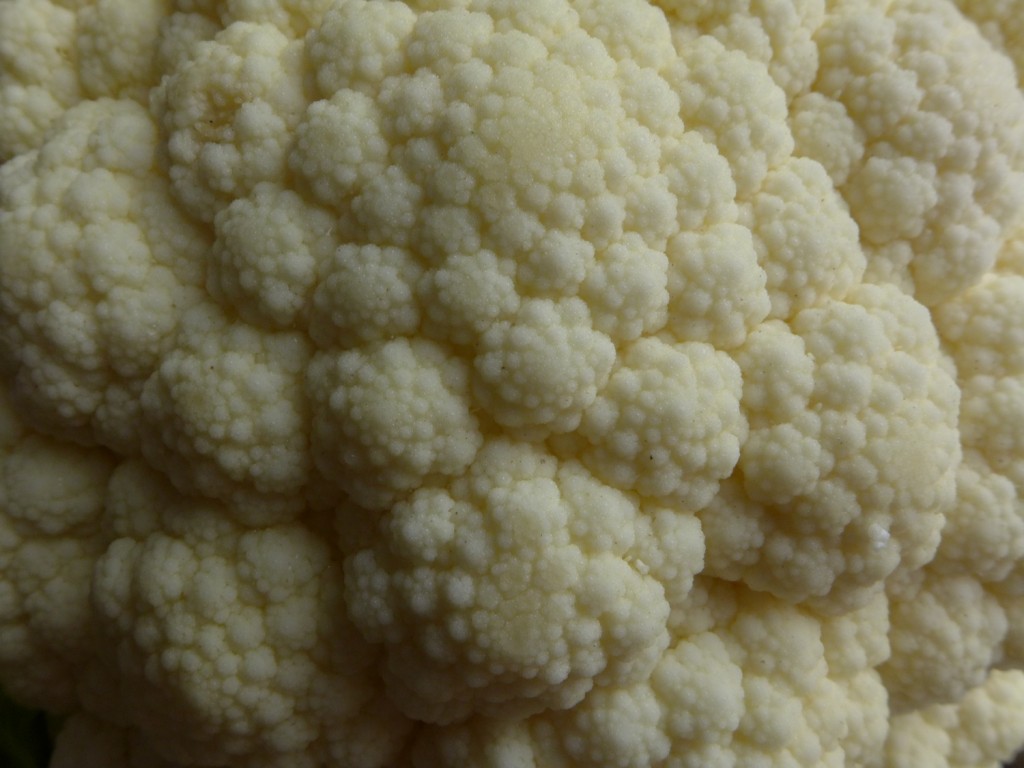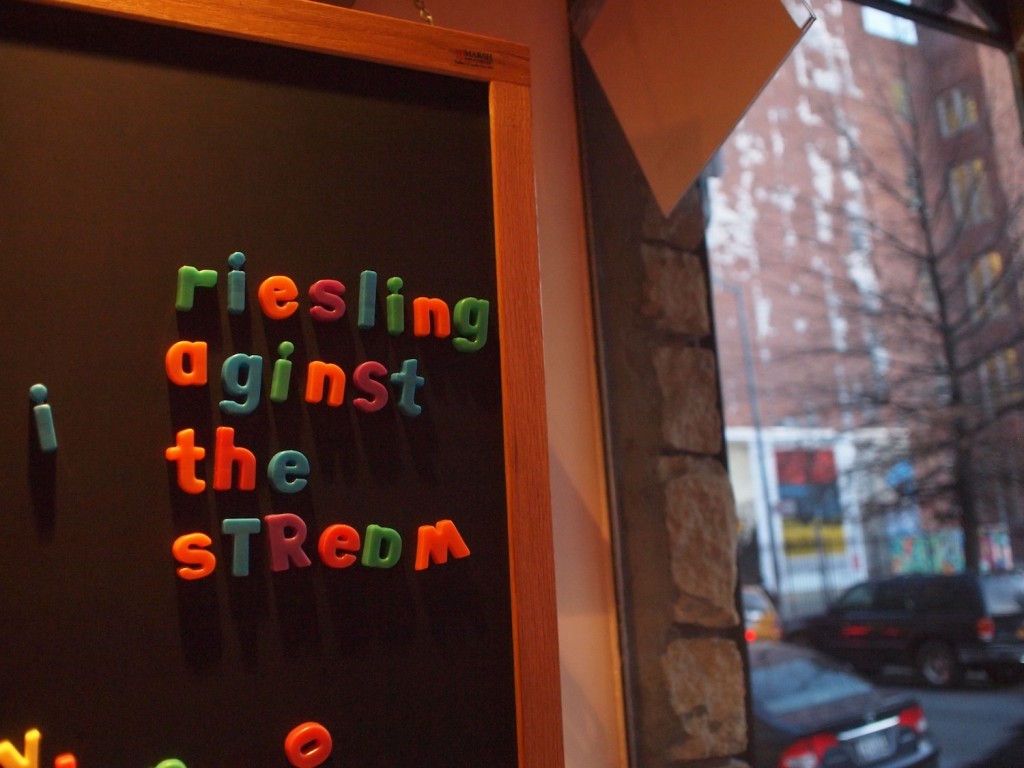What is a close up of a cauliflower doing at the top of this posting? Well, today we’re heading back into the Feiring Line, because in her book ‚Naked Wine’ (Da Capo Press, Cambridge/MA, 2012) Alice Feiring raises an issue of fundamental importance to Riesling and all other wines. I’m talking about the contentious question of the sulfur added by winemakers to nearly all wines. The freshness and stability of wine, including the great majority of organic and biodynamic wines, is dependent upon that sulfur. Its normally added in the form of sulfur dioxide (technical term: SO2), which dissolves in the wine where it acts as a preservative (technical term: antioxidant) and has a hygienic effect (technical term: bactericide). Put simply, what most of us regard as the fresh taste of clean wine would rarely, if ever, be possible without that sulfur dioxide.
“Natural” wines, or “naked” wines as Feiring prefers to call them, either have no added sulfur or almost none, and as she repeatedly points out that this makes them generally less stable and correct storage crucial. For her this negative is more than outweighed by the gains in taste she perceives, but many other professionals dispute. She points that some “natural”/ “naked” wines have an odd deep yellow or orange color (due to oxidation). However, she clearly considers such wines purer and more authentic than others.
Let me stress again how much I like the way Feiring writes. Most wine writing is leaden, either because the writer lacks the ability to bring the subject to life on the page, or because the format is so rigid that it forces the writer to try and walk with lead boots on. ‘Naked Wines’ shows what’s possible if the writer is talented, has a distinctive voice, and the format doesn’t drag the whole thing down to the banality of a shopping list.
Some of what Feiring writes disturbs me though. ‘Where and Who is in the Feiring Line?’ (see below), was all about what struck me as geographical prejudices (most strikingly against California and for France) in ‘Naked Wines’. Today the subject is sulfur in wine, which raises a fundamental question about the role of the winemaker, or “vigneron” to use Feirings term for winemakers who grow their own grapes. Is her/his role to protect wine from spoilage or should they let all natural process just blow because nature is holy? Don’t forget that microbial spoilage is also a natural processes. Stand by for a rocky ride through the Sulfur Zone!
On page 43 Feiring states that, “When I visited the Louis Pasteur Museum in Arbois I found myself transfixed by the gentle daffodil color of sulfur. So beautiful, so devilish.” Here it’s clear that she is talking about elemental sulfur, but sometimes during the following pages it’s very unclear whether “sulfur” refers to elemental sulfur, sulfur dioxide or other compounds containing sulfur. For example on page 44 she states, “Sulfur needs to be handled with respect. First of all it’s terribly toxic.” The reason why this lack of clarity is problematic is, that although some compounds like hydrogen sulfide (the smell of bad eggs, technical name: H2S) are terribly toxic, others are definitely not.
Also on page 43 Feiring’s states, “Sulfur is natural, and for that matter, so is arsenic and plutonium.” Plutonium only occurs naturally in trace quantities in uranium ore, but we’re talking about parts per trillion. Almost all the plutonium in the world was produced in nuclear reactors and separated from the spent fuel for nuclear weapons production, creating enormous amounts of nuclear waste on the way. I am a child of the Cold War and like untold millions of others grew up under the constant threat of nuclear annihilation. Uranium mining and ore processing, nuclear weapons production and testing killed thousands of people including many Americans. Around certain volcanoes you can pick up large chunks of elemental sulfur without any ill effect. Elemental sulfur is so harmless that high school kids play around with it in chemistry lessons. There’s an enormous difference between sulfur and plutonium and suggesting there isn’t is misleading. In this case it is tendencious, maybe also disingenuous.
The truth – I fear it is a painful truth for Feiring and the “natural” wine movement – is that sulfur is an essential element without which all life is impossible. Cystine and methionine are amino acids, members of the family of “building blocks” from which proteins are made, and both of them contain sulfur. So there’s a whole bunch of sulfur inside all of us. Nobody needs to dig under their skin to find the stuff though, because our skin itself also contains plenty of sulfur. Cystine is a crucial part of the protein keratin, the bond of two sulfur atoms at the center of the cystine molecule (technical name: disulfide bond) giving the outer layer of our skin its elasticity and strength. It is also an important component of our hair and Feiring has plenty of that if the photos of her on her website and the covers of her books are halfway up to date.
If she, or anyone else, is serious about avoiding sulfur in all its forms (which I don’t recommend unless you have allergy issues), then they need to start by cutting out proteins, which means meat, eggs, legumes and nuts. For example egg contains nearly 3000 parts per million of cysteine and peanuts contain slightly more than that. Both also contain a similar amounts of methionine. However, the trouble only starts there, because many fruits and vegetables also contain a lot of natural sulfur compounds, none more so than cauliflower (about 2000 parts per million!) closely followed by broccoli, brussel sprouts, cabbage, kale and kohlrabi.
All of them contain a compound called glucopanin. When we chew these vegetables an enzyme called myrosinase transforms glucopanin into sulforaphane. Recent research shows that under lab conditions sulforaphane inhibits the growth of breast cancer cells. I find that interesting because both my mother and my maternal grandmother had breast cancer. Maybe you also know someone who suffered from breast cancer? There may be other health benefits too. More research is needed to answer that question.
But we’re still not ready to leave the Sulfur Zone. Many of the funky aromas which the cool “natural” / “naked” wines Feiring enjoys have are the result of compounds which are aromatic because of the sulfur they contain. The mercaptans (correct technical name: thiols) are a prime example of this. They are also responsible for the characteristic natural aroma of grapefruit and for the smell of natural gas, which enables us to detect a gas leak (in this case the thiols are added). I enjoy grapefruit and like to cook with gas. Maybe you do too?
Now lets get down to the nuts and bolts of sulfur in Riesling and other wines. The first myth which needs debunking is that adding sulfur dioxide to wine is somehow modern, something new. Its use in German wine cellars was legalized at the Reichstag of 1497. I find it hard to imagine this could have happened without strong lobbying from the wine producers, many of who surely wanted official recognition for what was already normal practice in their cellars.
Today sulfur levels in conventional wines are lower than they were a generation ago and way lower than two or three generations ago. Despite what Feiring claims in her book (page 44), German wines are no exception to that rule. Most of the cool new generation German winemakers are very keen to achieve long living wines with the minimum of sulfur dioxide additions possible. Many of those who aren’t organic regularly bottle wines which would meet the recently tightened standards for their organic colleagues. However, the difference between a wine bottled with 90 parts per million sulfur dioxide and one with 120 is not significant for the health of the vast majority of consumers. So young German winemakers don’t make a big deal about it. They know that if you really wanted to kill yourself by drinking wine, then it would be the alcohol which would do the job not the sulfur dioxide!
For Riesling producers around Planet Wine sulfur dioxide is a necessary tool in the cellar both to keep their wines lively and to prevent undesirable microbes spoiling the wine (by starving them of the oxygen most of them need to grow). Not least amongst these are the acetic bacteria which turn wine into vinegar, a problem for some “natural” wines. Making great Riesling demands minimal handling of the wine, and this often means that the wines are slightly “reductive”, that is the opposite of oxidized, when freshly bottled. Feiring may be a taster who mistakes the yeasty reductive aromas of these wines for sulfur dioxide. It is a surprisingly common mistake amongst professional tasters. That’s just another reason to ask when Feiring and many of her colleagues are finally going to get real about sulfur.
And here is a “comment” from Justin Christoph which really deserves to be considered an entirely self-contained work:
Rieslingicity One and Two
Another subterranean morning
Sommelier screaming at the wine wall
We have to shout above the din of rice beef balls
We can’t taste anything at all
The chef recants litanies of bored food and gourmet frustrations
But we know all her suicide recipes are fake
-With one sip, with wine flow
-You will know
-Rieslingicity
-A sleep trance, a dream dance
-A shard romance
-Rieslingicity
GM only stares into the numbers
There’s only so much more alcohol he can take
There’s only so much more wine he can buy
Many miles away something crawls from the slime
at the bottom of a dark Finger Lake
-Always connecting to people
-Linked to the invisible
-Almost imperceptible
-Terroir inexpressible
-Science insusceptible
-Logic so inflexible
-Causally connectable
-Yet no wine is invincible
Another NYC ugly morning
The factory belches tweets into the sky
He walks unhindered through the industry tasting today
He doesn’t drink to wonder why
-If we share this terroir
-Then we can dream
-Spiritus mundi
-If you act as you drink
-The missing link
-Rieslingicity
The wine reps pout and scheme like cheap tarts on a red light street
But all he ever thinks to do is spit
And every single meeting with his so-called superior
Is a humiliating kick by that git
Many miles away something crawls to the surface of dark Hawea Lake
-We know you, they know me
-Extrasensory
-Rieslingicity
-A star tweet, text no call
-It joins all
-Rieslingicity
Another tasting day has ended
Only the happy hour hell to face
Packed like lemmings into shiny Parker Points
Contestants in a suicidal race
-Mosel so deep, Rhein so wide
-You’re inside
-Rieslingicity
-Effect without cause
-Subatomic laws, scientific pause
-Rieslingicity
The Somm grips the bottle and stares alone into the distance
He knows that something somewhere has to break
He sees the familiar tasting note now looming on his laptop
The pain upstairs that makes his palate ache
Many miles away there’s a shadow on Zeltingen door
Casting the vineyard’s Terroir
On a dark Mosel lock
Many miles away…




![120114_riesling_global_RZ [1600x1200]](http://www.stuartpigott.de/wp-content/uploads/2012/12/120114_riesling_global_RZ-1600x120020.jpg)
Rieslingicity One and Two
Another subterranean morning
Sommelier screaming at the wine wall
We have to shout above the din of rice beef balls
We can’t taste anything at all
The chef recants litanies of bored food and gourmet frustrations
But we know all her suicide recipes are fake
-With one sip, with wine flow
-You will know
-Rieslingicity
-A sleep trance, a dream dance
-A shard romance
-Rieslingicity
GM only stares into the numbers
There’s only so much more alcohol he can take
There’s only so much more wine he can buy
Many miles away something crawls from the slime
at the bottom of a dark Finger Lake
-Always connecting to people
-Linked to the invisible
-Almost imperceptible
-Terroir inexpressible
-Science insusceptible
-Logic so inflexible
-Causally connectable
-Yet no wine is invincible
Another NYC ugly morning
The factory belches tweets into the sky
He walks unhindered through the industry tasting today
He doesn’t drink to wonder why
-If we share this terroir
-Then we can dream
-Spiritus mundi
-If you act as you drink
-The missing link
-Rieslingicity
The wine reps pout and scheme like cheap tarts on a red light street
But all he ever thinks to do is spit
And every single meeting with his so-called superior
Is a humiliating kick by that git
Many miles away something crawls to the surface of dark Hawea Lake
-We know you, they know me
-Extrasensory
-Rieslingicity
-A star tweet, text no call
-It joins all
-Rieslingicity
Another tasting day has ended
Only the happy hour hell to face
Packed like lemmings into shiny Parker Points
Contestants in a suicidal race
-Mosel so deep, Rhein so wide
-You’re inside
-Rieslingicity
-Effect without cause
-Subatomic laws, scientific pause
-Rieslingicity
The Somm grips the bottle and stares alone into the distance
He knows that something somewhere has to break
He sees the familiar tasting note now looming on his laptop
The pain upstairs that makes his palate ache
Many miles away there’s a shadow on Zeltingen door
Casting the vineyard’s Terroir
On a dark Mosel lock
Many miles away…
Stuart,
that’s a great post. Very informative and beautifully written. We need more of that.
Combining cabbage and wine: What explains the cabbage smell in some great red Burgundies? Is that sulfur?
Karl
They are sulfides or disulfides, ofors range from cabbage, onion burnt rubber. It usually a sign of a not so optimal fermentation and bad nitrogen management. Ofcourse the French will tell you it’s an expresSion of their terroir
Stuart, thank you for this fascinating post. It’s refreshing to see actual science as a counter to dogma.
Like many wine professionals, I often feel caught in the middle of the “natural wine debate.” Many of my favorite wines are made with this philosophy in mind – many of them made by friends.
However, personal preferences aside – and disregarding for a moment the fact that I’ve also tried plenty of “natural” wines that I did NOT enjoy – I fear that there is a growing disconnect on the subject between trade & consumers.
The way that we are positioning “natural” in the market – and I’m as guilty as anybody else – carries with it the implication that wines which are not natural are also not good. Besides being patently untrue, we are projecting our own “rules” onto many consumers who may not have the frame of reference – or the confidence – to question them properly, to them with a grain of salt.
I believe our job as wine professionals is to help educate consumers and guide them towards wines that THEY will enjoy, not only to products that WE love.
Thank you again for sharing your thoughts, and provoking ours.
Awesome post! Great Poem. I’m borrowing both!
|